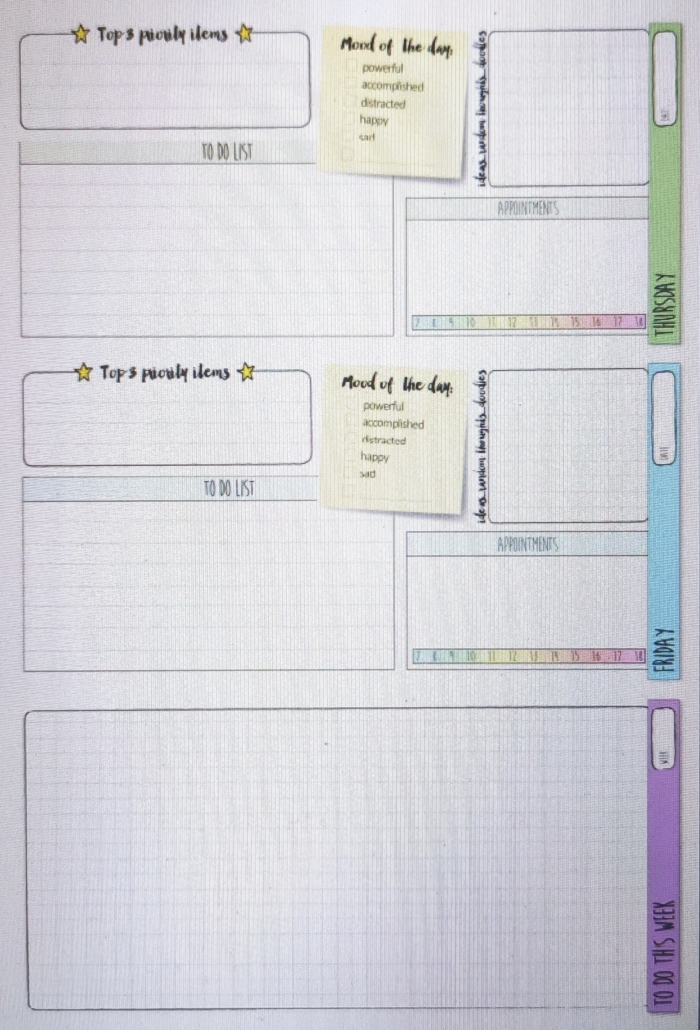The Benefits of A Mood Check In
___
BONUS FREEBIE: Want even more ways to stay organized, productive and less stressed? Click here to get access to my List-Making Starter Kit. It will boost your efficiency and get you back to doing more of the things you love.
___
As you know, I’m a big fan of taking the last 20 minutes of my day to jot down all my to-do’s for tomorrow. It helps me set my intentions and track what I want to get done. It’s a ritual that I lay out in my first book Listful Thinking.
Recently, one of my readers, Kim from Frankfurt, Germany, reached out to me about an additional category she added to her nightly to -do list. And I really like the idea!
A mood check-in section.

Kim uses this template with photos at the end of every day. This has helped her build awareness so she can see how she wants to take action and make positive changes in her life.
I’ve done a similar thing for years after big events or when I start working with a new client. But I started doing mood check-ins every day and at the beginning of meetings.
This habit has definitely made a positive impact on my team and our workflow.
Here are some of the ways that mood check-ins can help…
1) Celebrating your wins.
Maybe that presentation you were nervous about giving went really well. Or you found a dollar in an old coat pocket. Or you received a nice message from an old friend.
Writing down or drawing a picture of something that made you happy during the day is a great way to reinforce your positivity and gratitude.
Taking a few minutes to celebrate your daily wins (whether big or small) is a great habit that will boost your mood over time.
2) Building awareness and recognizing patterns.
But let’s be honest. Some days are just bad days.

It’s just as helpful to record those moments!
I consider myself to be a pretty happy person, but there are times I’m in a bad mood too. Expressing when I’m sad or angry or scared helps me let those feelings pass.
Whether something happened or you just woke up not feeling great – recording those feelings can help you process them. I have templates for this in my book Listful Living: A List-Making Journey to a Less Stressed You.
You’ll also be able to notice if there are any patterns to when you’re not feeling your best.
And once you’ve noticed a pattern, you can do something about it.
Which leads me to the next benefit…
3) Taking action and making positive changes.
You might notice that a recurring task or situation with someone is consistently bringing down your mood. Or that there’s a hobby you’ve tried to start but haven’t, and you’re feeling guilty about it.
(I talk about that last one in my LinkedIn Learning course The Power of Lists.)
The good news is, once you notice that pattern, you can adjust it. Maybe the solution is delegating the task to someone else, having a necessary conversation with a friend, or just taking that hobby off your list.
Not everything will have an easy solution, but your awareness will help you integrate changes to improve your mood, your productivity, and your life.
4) Team bonding.
Checking in on your mood doesn’t need to be a solo activity!
Checking-in with your team at work before diving into work, or with a partner can help you get to know each other better. You can celebrate each other’s wins, give and receive encouragement when it’s needed, and express your feelings in a healthy way.
(What an awesome benefit to celebrate in your first mood check-in!)
I do my mood check-ins with co-workers and clients. Kim draws it out at the end of her day. If talking in groups, or paper lists aren’t your thing, there are even apps like Moodnotes you can use to check-in.
Try different methods or invent a new one until you find the way that works best for you. And start building this healthy habit today!
___
BONUS FREEBIE: Want even more ways to stay organized, productive and less stressed? Click here to get access to my List-Making Starter Kit. It will boost your efficiency and get you back to doing more of the things you love.
___







Leave a Reply
Want to join the discussion?Feel free to contribute!